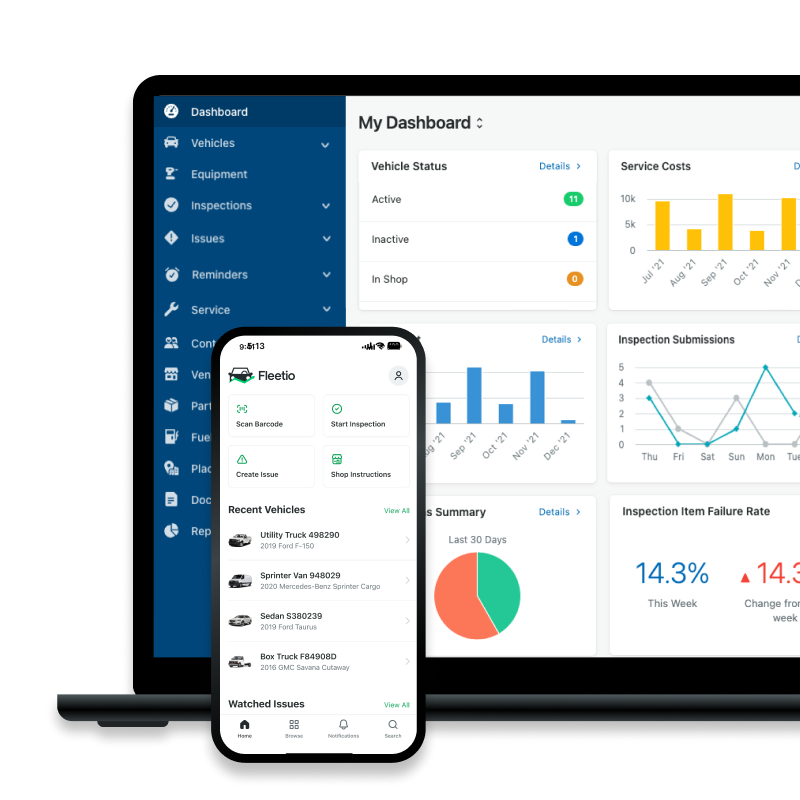4 Steps to Optimize the Fleet Warranty Management Process
Fleet asset warranties can be lifesavers when it comes to managing fleet maintenance costs. Let's dive into a few key aspects of fleet vehicle warranty management, like how to file a claim, what is covered under warranty, how to track policies and the role that software solutions can play in streamlining the warranty management process.
Jul 26, 2024
7 min read

Fleet asset warranties can be lifesavers when it comes to managing fleet maintenance costs, saving your fleet big on expenses in repairs and replacements. In this blog, we will dive into a few key aspects of fleet vehicle warranty management, like how to file a claim, what is covered under warranty, how to track policies and the role that software solutions can play in streamlining the warranty management process.
Benefits of Fleet Warranty Management
Tracking warranties is of utmost importance for fleets if they want a better way to manage repair costs, ensure timely maintenance and maximize asset value and longevity. By monitoring warranties, fleets can avoid unnecessary expenses by leveraging coverage for repairs and replacements, ensuring that maintenance is performed within the warranty period to prevent voiding coverage. On top of that, tracking warranties provides valuable data for planning asset replacements and maintenance schedules, which ultimately extending the lifespan and performance of fleet assets.
Track assets, parts & warranties in one platform
There’s a better way to manage your warranty information that doesn’t involve endless folders and spreadsheets – Fleetio can help you stay on top of active vehicle and part warranties and track your credits.
Learn MoreHow to File a Claim Under Warranty
Filing a claim under warranty is a fundamental step in managing fleet issues, but it can feel a little clunky and bureaucratic. When a covered component in your fleet vehicle malfunctions or fails, you’ll want to make sure you’re following the manufacturer's procedures for filing a warranty claim to stay within your warranty’s requirement and get the service fully covered within your policy. This includes documenting the issue, gathering necessary information such as vehicle details and maintenance records, and submitting the claim through the appropriate channels.
Here’s a step by step list for filing a claim under warranty.
1. Document the issue
Identify and document the specific problem or malfunction with the vehicle and make note of any relevant symptoms, noises, or warning lights associated with the issue.
2. Refer to warranty documentation and check for eligibility
Review the warranty documentation provided by the vehicle manufacturer or warranty provider to see if there are any covered components or systems related to the reported issue. Make sure the vehicle is still within the warranty period, and verify that the reported problem is still covered under the terms of the warranty.
3. Gather necessary information
Collect key information about the vehicle, including make, model, year, and VIN (Vehicle Identification Number), as well as maintenance records and documentation to show continued upkeep and adherence to service schedules.
4. Contact an authorized service center
Get with an authorized service provider or dealership affiliated with your vehicle’s OEM and ask about the specific procedures and documentation required for filing a warranty claim. Schedule an inspection or repair appointment with the authorized service center and provide them with all relevant information and documentation they need to get the job done. The service provider will then inspect and diagnose the issue.
5. Submit the claim
Adhere to the manufacturer's specification for filing a warranty claim and complete any claim forms or documentation as required by the warranty provider. Submit the completed warranty claim to the designated contact or department. Make sure to include all necessary supporting documentation, such as inspection reports, invoices, and service records.
6. Track your claim
Monitor the status of the warranty claim after submission, and be sure to follow up with the warranty provider or service center for updates on the processing and approval of the claim. Address any additional requests they may have to expedite claim approval.
7. Receive authorization and reimbursement:
Once the claim is approved, obtain authorization for the repair or replacement, and get reimbursed for covered expenses as outlined in the warranty agreement.
4 Steps for Tracking Fleet Warranty Policies
Effective warranty management, outside of simply filing claims, involves meticulous tracking of vehicle warranty policies to ensure timely claims and prevent any lapses in coverage. There are also a few things outside of warranty tracking you’ll need to do to maintain your claim eligibility. Here are a few best practices for managing and tracking your warranty policies.
1. Keep your documentation organized at all times.
Make sure you always have all documentation related to the vehicle's warranty, including the warranty agreement, terms and conditions and any supplementary documents. Establishing an accessible, centralized database or physical folder can help significantly reduce any likelihood that your documentation goes missing.
2. Record everything
Document essential information, including:
- Warranty start and end date
- Covered components and systems
- Exclusions or limitations
- Contact information for the warranty provider
You’ll also want consistent vehicle maintenance and service records, with date, mileage and service details including alongside whether the service was covered under warranty or paid for out of your maintenance budget.
3. Set reminders and regularly review warranty coverage
Utilize digital tools to set reminder alerts for important warranty milestones and receive notifications for upcoming warranty expiration dates or recommended maintenance checks. When milestones come up, review your warranty coverage details to stay informed about what is included and excluded.
4. Review warranty claims history and consider extended warranty option
Keep a record of past warranty claims and their outcomes, and then use this information to identify patterns, assess the reliability of certain vehicle components, and inform future maintenance decisions. You’ll also want to see if extending warranty coverage for critical components beyond the manufacturer's standard warranty period may be cost-effective for your fleet.
What is Covered Under Warranty?
Understanding what is covered under warranty is the first step in making informed decisions about vehicle maintenance and repairs. Different manufacturers and warranty plans have different coverage for components and systems. Here is a list of common warranty coverages and the parts and services they generally cover.
1. Powertrain Components
- Engine
- Transmission
- Drive axles
2. Emissions systems
- Catalytic converter
- EGR (Exhaust Gas Recirculation) system
- Oxygen sensors
3. Corrosion and rust protection
- Coverage for rust and corrosion damage to the vehicle's body and chassis
4. Basic components
- Fuel system components
- Cooling system components
- Ignition system components
5. Factory-installed audio and entertainment systems
- Radio
- CD/DVD player
- Touchscreen display (if factory-installed)
6. Safety restraint systems
- Airbags
- Seat belts
- Occupant classification system
7. Suspension components
- Shocks and struts
- Control arms
8. Brake components
- Master cylinder
- Brake calipers
- Brake boosters
9. Electrical systems
- Alternator
- Starter motor
- Wiring harnesses
10. Climate control systems
- Air conditioning components
- Heater core
11. Factory-installed accessories
- Power windows and locks
- Keyless entry system
- Remote start system
12. Hybrid or electric vehicle components
- High-voltage battery pack
- Electric motor and related components
An important note: While these components are often covered under a new vehicle warranty, the specific terms and duration of coverage can vary from manufacturer to manufacturer. Some parts may be covered by separate warranties depending on your coverage (e.g., a longer warranty for the powertrain). Extended warranties or service contracts may also be available to cover additional items or extend coverage beyond the standard warranty period. To get precise details about what is covered, always be sure to pay attention to the warranty documentation provided by the vehicle manufacturer.
The Role of Software in Warranty Management
Modern fleet management software like Fleetio can be a game changer in creating greater efficiency and transparency in fleet warranty management. Fleetio offers robust warranty tracking for fleets in combination with the rest of your fleet data, with features like:
- Centralized warranty information,
- Automated warranty tracking,
- Integration with maintenance records,
- Maintenance cost analysis,
- Real-time vehicle health monitoring with integrated telematics,
- Documentation and compliance,
- and customized data reporting.
All of fleet management in one place
Unify all of your fleet data in a single platform, designed to give you ultimate visibility into every corner of your operation.
Try it out
Senior Fleet Content Specialist
As a Senior Fleet Content Specialist at Fleetio, Peyton explores the voices and experiences that shape fleet operations. She focuses on how fleet professionals adopt technology, improve efficiency and lead their teams to bring clarity and context to the challenges happening across the industry.
View articles by Peyton PanikReady to get started?
Join thousands of satisfied customers using Fleetio
Questions? Call us at 1-800-975-5304


